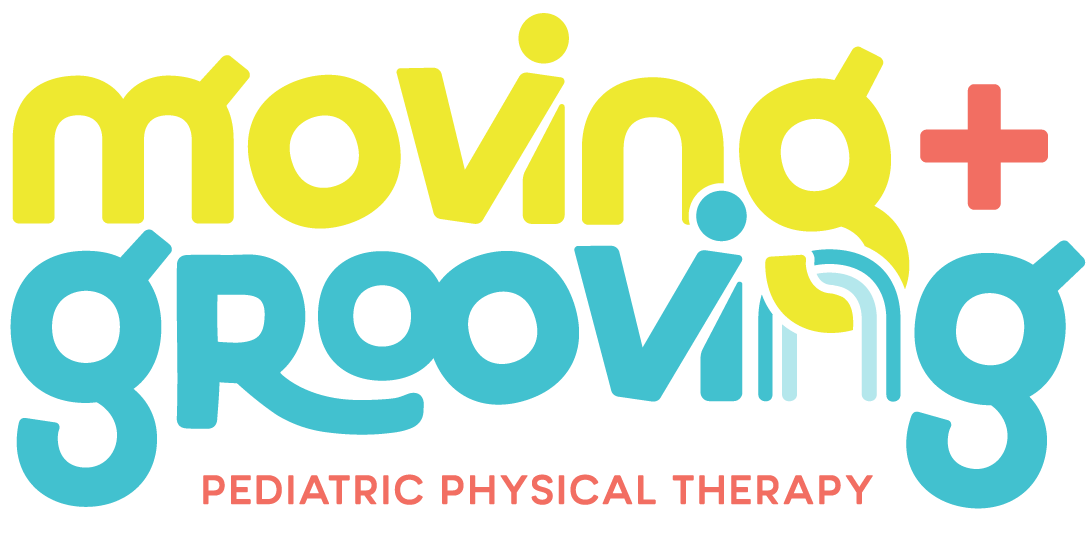
How does pediatric physical therapy (PT) help with Cerebral Palsy (CP) ?
First of all, what is cerebral palsy? CP occurs as a result of a brain bleed, the same as adult who experiences a stroke. This can be due to lack of oxygen or a blood clot or broken blood vessel. CP is a condition that always has a physical effect on the body, and sometimes has an effect on the cognition of the child. Some children with CP experience seizures, and others visual deficits. CP is not progressive. It is diagnosed via clinical presentation, reflex assessment and imaging of the brain.
Red flags for CP include lack of awareness of 1+ limbs, an arm or leg preference as an infant, difficulty using one side of the body to balance or bear weight, extremely low or high muscle tone (hypotonia and hypertonia), little to no head control when pulled up from laying down, difficulty bending knees or ankles, fisting of a hand, difficulty bringing hands to midline, demonstrate atypical or asymmetrical crawling, unable to initiate stepping when placed in standing or crossing legs when attempting to walk. If your child demonstrates any or multiple of these risk factors, express your concern to your pediatrician immediately. If your child has CP, they are generally referred to physical, occupational, speech and/or feeding therapy and followed by a neurologist. Therapies have been found to be incredibly helpful in improving the abilities and quality of lives of children with CP.
PT can help a child with CP in multiple ways, including improving the child’s endurance, mobility, safety accessing their environment, choosing and fitting the most appropriate durable medical equipment (such as a walker/ gait trainer/ crutches/orthotics), flexibility, strength, posture and balance. Depending on the type and severity of CP, along with the age, cognition and abilities of the child, the sessions will look different. Here are several examples:
Quadriplegic CP: Sessions focus on activating, stretching and strengthening both arms and both legs. Much focus is on core strengthening and using the limbs to support the child’s weight when they are moving outside of their base of support (whichever body parts are in contact with the ground). PTs will focus on orthotics, standers, wheelchairs, and other durable medical equipment to improve the child’s mobility and maintain their muscle, bone and joint integrity.
Hemiplegic CP: Sessions focus on activating, stretching and strengthening the affected side of the child. There may be increased demands on the affected side to bear weight during some activities, and mobilize during others. If the child’s right side of the brain is affected by their CP, many times there is more time spent on bringing awareness to the left side of the body due to a potential side effect of left neglect. Many times, orthotics may be used to prevent injury or reduce the risk of contracture formation (the limb becomes stuck in place).
Hypotonic CP: Sessions focus on activating and strengthening the child’s musculature, particularly their core, and their endurance. These children present as very floppy (sometimes in therapy we refer to this as feeling like a wet noodle) and have difficulty maintaining their posture without support. Many times, a SPIO vest or compression garments are utilized to provide more body awareness and support to the core, shoulders and hips. Heavy work is often utilized to help the child activate their core and understand where their body is in place. Many of these children prefer to stay on their backs, have an extreme intolerance of tummy time, are frequently found leaning on people or furniture for additional support, and have low activity tolerance.
Hypertonic or Spastic CP: Sessions focus on stretching, mobilizing and stabilizing the affected joints. These children are often described as rigid and are seen extending and falling backwards and/or stand and walk on their tiptoes. When their muscles are stretched too quickly, they may demonstrate clonus (repetitive bouncing). Activities that focus on finding midline to bring the hands together, playing in weight bearing positions with the body leaning forward, and positions that require the tight muscle to stretch, are often utilized in PT. These children have a difficult time using just 1 muscle to perform a task, lacking dissociation (separate movements) and therefore utilizing more energy than necessary to perform basic tasks. Many children with hypertonic CP also utilize their head and neck to cause forward movement of their legs when walking.
Dystonic CP: Sessions focus on controlled movements of the affected muscles. Children with this present with a “writhing” motion of their muscles, or not having control when certain muscles turn on. This can cause difficulties with hand-eye or foot-eye activities, balance, posture, and overall coordination. This can also affect the facial musculature and cause unwanted facial expressions and/or drooling.
Ataxic CP: Sessions focus on body awareness, balance and coordination. Children with ataxic CP have difficulties with controlled, precise movements. Their movements may be described as discoordinated. Asking a child with ataxic CP to reproduce a specific motion or move their hand or foot to an exact target is very difficult due to their limited control of their muscles. Learning strategies to cope with limited body awareness and coordination helps these children reduce their fall risk and have improved safety on the playground or in physical education class. Many children with ataxic CP will require assistive devices such as walkers or gait trainers.
Mixed CP: Sessions combine strategies from hypertonic/ spastic and hypotonic CP. These children have certain muscles that are very tight and others that are very loose.
If you have questions about whether or not physical therapy would be a good fit for your child with cerebral palsy, call to schedule a free consultation.
